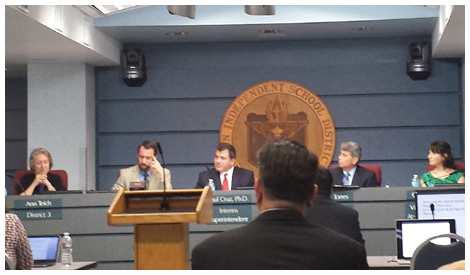 This week, I had the pleasure of speaking to members of the Austin Independent School District Board of Trustees about the Construction Career Collaborative (C3). As a journalist who's covered the program’s development in Houston, I felt the board should at least know about it as they consider how to improve the lives of the workers on AISD construction projects.
This week, I had the pleasure of speaking to members of the Austin Independent School District Board of Trustees about the Construction Career Collaborative (C3). As a journalist who's covered the program’s development in Houston, I felt the board should at least know about it as they consider how to improve the lives of the workers on AISD construction projects.
I have a son in the Austin school district. He’s 15 and at that age when a young man tries to figure out what he’s going to do with his life. He may go to college and pursue a four-year degree or he may decide he’d rather do something in the skilled trades. I will be proud of him no matter what. My concern is that if he chooses the latter, he may not be able to hold his head high and provide for his family because the investment hasn't been made in the workforce.
As we’ve reported on Construction Citizen many times, the industry all too often does not invest in its workers in a way that will create a sustainable workforce. That’s why I wanted to make sure that as the Austin school district prepares to spend millions on construction under a newly approved bond package, they’re creating the kind of jobsites where they would want AISD graduates to work.
Some concerns have been raised by members of an advisory committee about making sure that workers receive safety and craft training as well as increased wages. On the training issue, C3 could not be more appropriate.
As our readers know, C3 is a voluntary program for owners. Those owners of projects demand that their contractors require all workers to get hourly pay with overtime earned, pay and match payroll taxes, provide accident insurance and receive safety training. In other words: general contractors and their subcontractors must follow the law.
Early adopters of the Construction Career Collaborative include MD Anderson Cancer Center, Texas Children's Hospital, and the Archdiocese of Galveston-Houston. When those owners learned about the program, their question was not whether they should do this – they just wanted to know how they could get started.
Some groups spoke in favor of raising wages for workers to the Davis-Bacon wage scale.
AGC Austin President Phil Thoden had a slightly different take.
“While adoption of the Davis-Bacon scale for AISD school construction has some merits, the fundamental problem is that not all trades would see a wage floor increase. In fact, many would see their wage floor set well below what the 2006 AISD wage survey allows. It’s curious to me that local workers’ rights groups are comfortable supporting the Davis-Bacon scale for AISD projects even though several wage rates fall below the $11 to $12 ‘living wage’ level they consistently and vocally cite as the lowest acceptable floor for Austin’s construction workforce,” Thoden said. “The expectation is that market rates will adjust those lower rates to reflect the current workforce shortage, but if that’s OK on the lower end, then why is it not OK on the higher end of the wage scale?
“As an alternative to Davis-Bacon, the Austin AGC would support AISD adopting market labor rates along with the ‘C3 approach’ to address safety, hourly pay, workers’ comp and related issues. This concept is gaining ground in the Houston construction market but has yet to be tested in Austin. Unfortunately, since construction wages were not part of the discussion during the 2013 school bond campaign and have only recently drawn the attention of the AISD school board, there’s not much time to settle all the wage and benefit issues in a comprehensive way before summertime school projects kick off.”
The Austin School Board will meet again June 16 to talk more about this.
Austin School Board Hears about the Construction Career Collaborative
by Scott Braddock | June 04, 2014



Add new comment